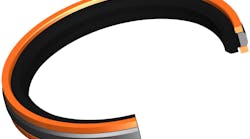The Hallite 730 double-acting piston seal features a four-part assembly and is designed for use in heavy-duty applications. It is beneficial for use in applications requiring position-holding capabilities.
Key features of the piston seal include:
- face seal comprised of wear-resistant thermoplastic polyester elastomer (TPE)
- suitable for maximum pressures of 700 Bar
- compatible with various fluids including hydraulic oils and water-based fluids
- contains a pair of rectangular polyacetal anti-extrusion rings.
Durable Design Aids Use in Harsh Applications
Use of a tough TPE material for the face seal ensures suitability for both roller-burnished and honed tubing. Alternate materials can be provided when needed such as lubricated polyester and PTFE.
The face seal is also pre-loaded by a profiled nitrile rubber energiser, helping to provide further durability for piston sealing. A pair of rectangular polyacetal anti-extrusion rings are included on the 730 piston seal as well, again aiding durability and sealing capability.
Benefiting the seal's use in various heavy-duty applications is its operating temperature range of -40 to 110 degrees C when used with hydraulic oils and 0 to 60 degrees C with water-based fluids. It also features a maximum speed of 0.3 m/sec.
Hallite first introduced the 730 in 1980 to bring new sealing technology for mining leg cylinders to the market. It included polyester face rings combined with NBR energizers like the current design, indicating the lasting applicability of these sealing technologies. The company specifies the 730 double-acting piston seal suits use for longwall mining roof support applications and large diameter crane cylinders, demonstrating its capabilities in these heavier duty, harsher applications.


